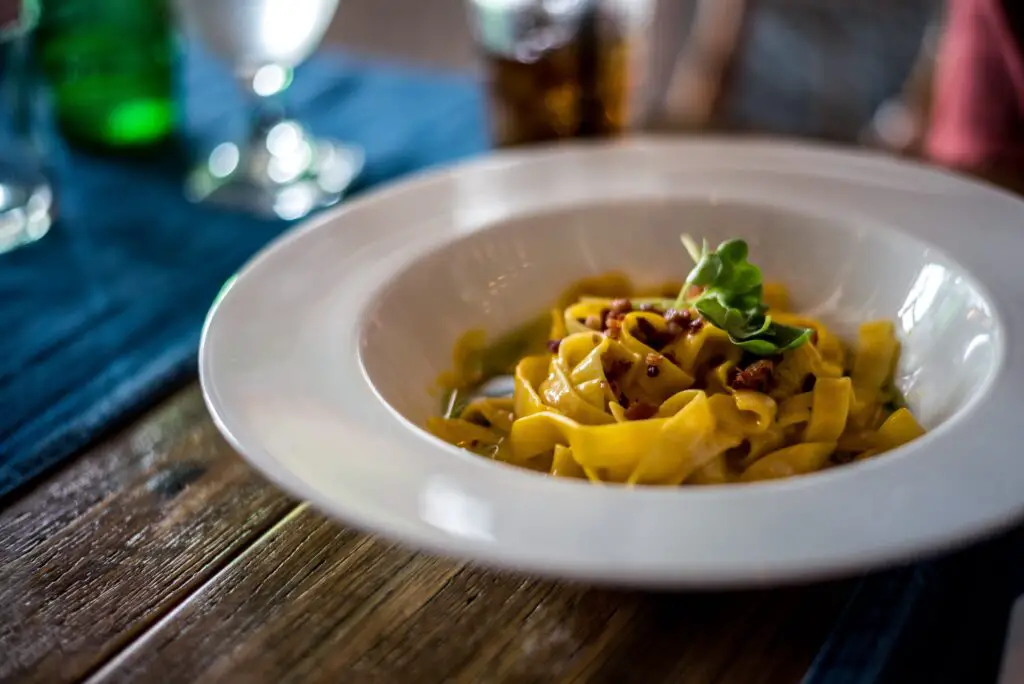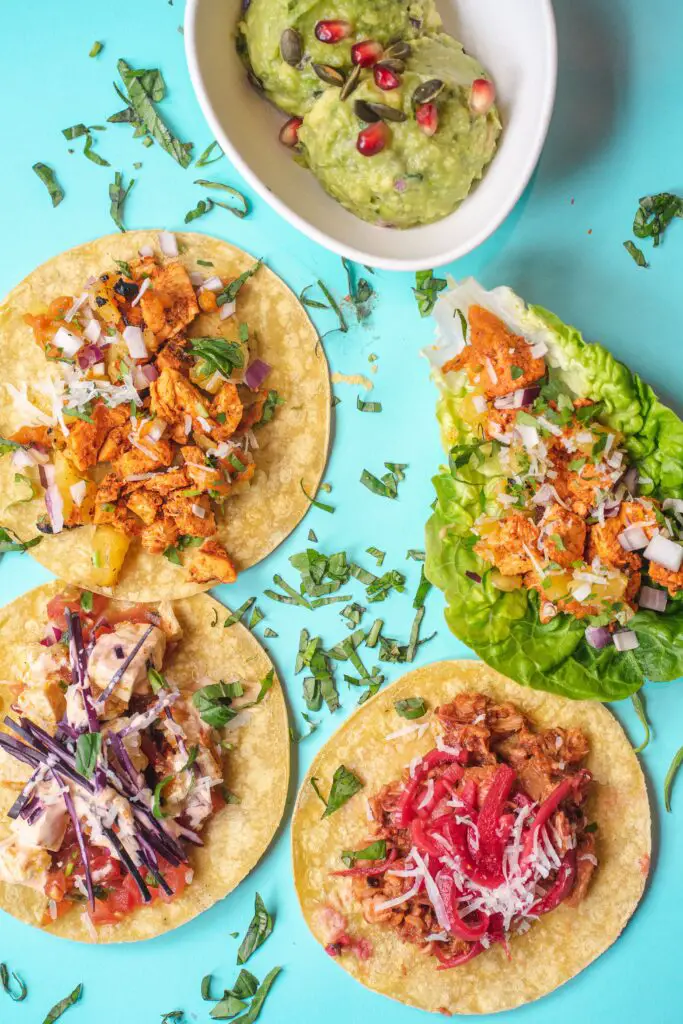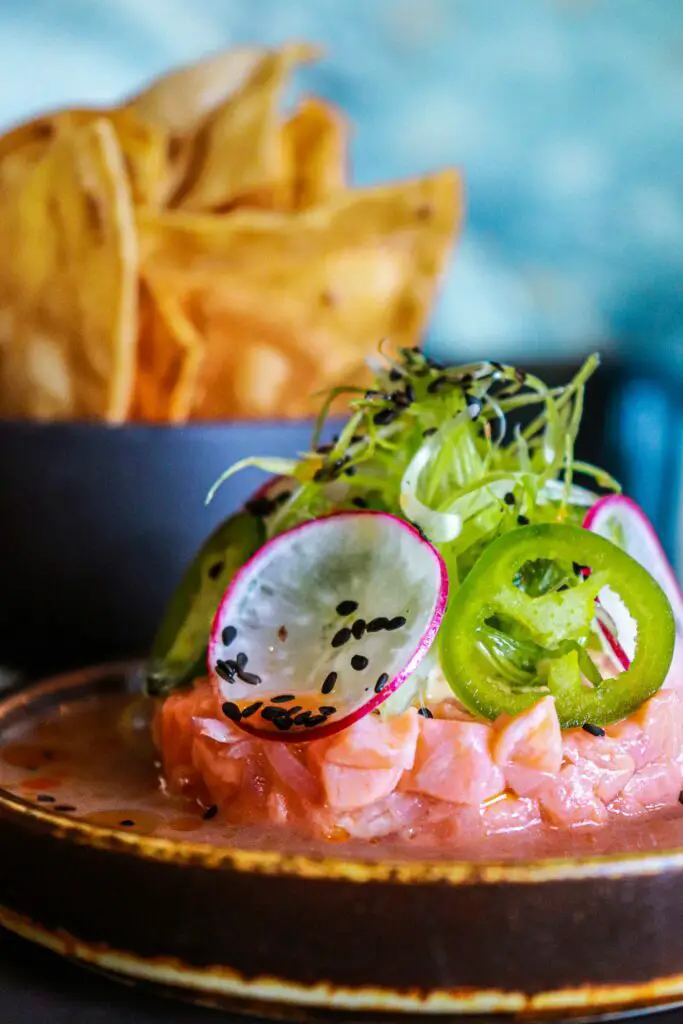Phoenix, a sun-drenched jewel in the heart of the Sonoran Desert, isn’t just renowned for its mesmerizing sunsets and iconic saguaro cacti. This vibrant city has emerged as a melting pot of global cultures, and nowhere is this more evident than in its culinary landscape. Tucked away in its bustling streets and sunlit corners, Phoenix boasts an array of eateries that transport diners straight to various corners of the globe.
While Latin American flavors, from the aromatic spices of Mexico to the tantalizing grills of Argentina, undeniably shine bright in the city, Phoenix’s culinary tapestry is further enriched by the fragrant spices of African dishes and the hearty comfort of American classics. Additionally, the intricate delicacies of the Asian kitchen offer a delightful contrast, presenting a harmonious blend of tradition and innovation. As part of our culinary journey, “Taste the World in Phoenix“, we invite you to traverse continents with just your palate, exploring the authentic and diverse cuisines that have found a home in Phoenix. Prepare to embark on an unforgettable gastronomic adventure that promises to tantalize your taste buds and enrich your understanding of these vast and vibrant culinary traditions.
Whether you’re a seasoned traveler, a passionate foodie, or simply a curious diner, Phoenix’s diverse culinary scene promises an exploration like no other. Let’s dive in!
Table of Contents
The Essence of Latin American Cuisine:
Latin America, a vast expanse stretching from the arid plains of Mexico in the north to the windswept archipelagos of Tierra del Fuego in the south, is a region of unparalleled diversity. Its cuisines, an exquisite mosaic of flavors, are a testament to the area’s rich tapestry of histories, cultures, and geographies.
At the core of Latin American cuisine lies the influence of three predominant ancestries: the Indigenous peoples, who cultivated maize, chili peppers, beans, and potatoes long before any external contact; the Europeans, primarily the Spanish and Portuguese, who introduced dairy, wheat, and meats into the culinary fold; and the Africans, who, brought over during the colonial period, infused the region with unique cooking methods and ingredients such as plantains and okra.
Here are some of the unifying threads that bind the vast and varied cuisines of Latin America:
- Staple Ingredients: Maize, often manifested as tortillas in Mexico or arepas in Venezuela and Colombia, is the backbone of many dishes. Beans, rice, potatoes, and chili peppers further form the quintessential base of numerous culinary creations.
- Diverse Proteins: From the beef-heavy grills of Argentina and Uruguay to the seafood-rich dishes of coastal nations, protein plays a central role. Whether it’s chicken, pork, or even exotic meats like guinea pig in the Andes, there’s a rich variety to be found.
- Flavor Profiles: Latin American cuisines are known for their bold and vibrant flavors. Herbs like cilantro and oregano, spices like cumin and achiote, and the generous use of chili peppers ensure that dishes are packed with layers of taste.
- Cultural Fusion: The melding of cultures over centuries has resulted in a fascinating blend of flavors. The African influence on Brazilian feijoada or the German impact on Chilean pastries showcases the delightful outcomes of such culinary fusions.
- Regional Variations: It’s crucial to remember that each country, and even regions within countries, have their unique take on dishes. For instance, ceviche, a seafood delicacy, varies markedly from Mexico to Peru.
As we traverse through the cuisines of Latin America in the streets of Phoenix, remember that each dish, each flavor, represents a story. A story of ancient civilizations, colonial legacies, and vibrant cultures coming together on a plate. And now, without further ado, let’s journey through the distinctive tastes and textures of Latin American nations, right here in Phoenix.
Argentinean Cuisine
Argentina, a vast nation characterized by its sweeping pampas, towering Andes, and vibrant cosmopolitan cities, offers a culinary landscape as diverse as its geography. Renowned for its premium beef, Argentinean cuisine is a delicious interplay of indigenous traditions and European influences, particularly from Italy and Spain.
- The Pinnacle of Grills – Asado: At the heart of Argentinean cuisine is the revered ‘asado’ or barbecue. This isn’t just a cooking method; it’s a social event, a celebration. Choice cuts of beef, ribs, chorizo, and even organs are slow-grilled over wood or charcoal, resulting in smoky, tender morsels of meat that are a carnivore’s dream. The ritual of gathering around a grill, sharing stories and laughter, is as much a part of the dish as the meat itself.
- Empanadas: These delightful pastries, with origins from Spain, have found a unique expression in Argentina. Stuffed with a myriad of fillings, from minced beef, onions, and hard-boiled eggs to sweet variations with quince jam, empanadas are the perfect snack or appetizer. Regional variations abound, with the province of Salta offering a spicier version, while those from Tucumán are juicier and smaller.
- Milanesa: A nod to Italian influences, the milanesa is a breaded and fried meat cutlet, reminiscent of the Austrian schnitzel. Typically made with beef or chicken, it’s crispy on the outside, tender on the inside, and often topped with ham, cheese, and tomato sauce in a ‘Milanesa a la Napolitana’ style.
- Wines and Yerba Mate: No mention of Argentina is complete without its wines, especially those from the Mendoza region. Malbec is the star, with its deep, fruity notes and velvety finish. Equally iconic is yerba mate, a traditional drink made from the dried leaves of the Ilex paraguariensis plant. Shared among friends from a hollowed gourd, it’s more than a drink; it’s a ritual of camaraderie.
In Phoenix, the spirit of Argentina is alive and sizzling. From dedicated Argentinean steakhouses to cozy eateries offering empanadas with myriad fillings, the city ensures you’re never too far from experiencing a slice of this South American gem.
Bolivian Cuisine
Tucked away in the heart of South America, Bolivia is a land of contrasts. From the towering Andean peaks to the vast, flat salt plains of Uyuni, its dramatic landscapes are mirrored by a cuisine deeply rooted in indigenous traditions with Spanish influences, resulting in flavors that are both hearty and earthy.
- Salteñas: Often mistaken for empanadas, salteñas are a Bolivian breakfast favorite. These oven-baked pastries, with a slightly sweet, golden crust, encase a juicy filling of meat (usually chicken or beef) combined with a flavorful sauce, peas, hard-boiled eggs, and sometimes even raisins and olives. The trick is to eat them without spilling any of the delectable juices!
- Llajwa: This fiery, tomato-based salsa is a staple of Bolivian tables. Made with locoto peppers, tomatoes, and sometimes onions, all finely chopped, llajwa complements almost every dish, adding a spicy kick that’s uniquely Bolivian.
- Anticuchos: Skewers of beef heart marinated in a rich blend of garlic, cumin, and aji pepper, anticuchos are a popular street food. Grilled to perfection, they’re usually served with boiled potatoes and a generous dollop of llajwa.
- Quinoa: Long before quinoa became a global ‘superfood’, it was a staple grain in the Bolivian Andes. Used in soups, as a side dish, or even in desserts, quinoa showcases the rich agricultural heritage of Bolivia.
- Sopa de Maní: This hearty peanut soup is a testament to Bolivia’s love for rich, comforting broths. Made with ground peanuts, beef, pasta, and vegetables, it’s a wholesome dish that warms you from the inside out.
In the bustling streets of Phoenix, the essence of Bolivia comes alive. Whether you’re tucking into a salteña at a local bakery or enjoying a bowl of sopa de maní in a tucked-away eatery, the city offers a window into the heart of Bolivian culinary traditions.
Brazilian Cuisine
Brazil, the largest nation in South America, offers a carnival of flavors as vibrant and diverse as its famed festivals. With influences ranging from its indigenous peoples to Portuguese, African, and Japanese immigrants, Brazilian cuisine is a delightful fusion that tantalizes the palate with its variety and zest.
- Feijoada: Often hailed as Brazil’s national dish, feijoada is a robust black bean stew simmered with various cuts of pork, ranging from sausages to smoked ribs and even trotters. Traditionally enjoyed on Saturdays, this dish is accompanied by rice, collard greens, and a sprinkle of farofa (toasted cassava flour), creating a medley of flavors and textures.
- Churrasco: Brazilian barbecue, or churrasco, is a meat-lover’s dream. Skewers of beef, chicken, pork, and even lamb are seasoned, often simply with salt, and grilled over open flames. In churrascarias (steak houses) across Phoenix, diners can experience this rotating spectacle of meats, carved right at the table.
- Acarajé: With African roots, acarajé is a deep-fried ball made from black-eyed pea dough, stuffed with vatapá (a spicy shrimp and cashew paste) and caruru (okra, shrimp, and nut sauce). This street food favorite reflects the rich African influence on Brazil’s northeastern culinary traditions.
- Coxinha: A beloved snack, coxinha is a teardrop-shaped croquette filled with seasoned chicken and creamy cheese, encased in a crispy breadcrumb shell. Perfectly bite-sized, it’s the ideal accompaniment to a cold beverage.
- Caipirinha: Brazil’s iconic cocktail is a refreshing blend of cachaça (a sugarcane-based spirit), lime, sugar, and ice. Simple yet potent, the caipirinha embodies the spirit of Brazil — vibrant, lively, and unforgettable.
Phoenix, with its ever-evolving culinary scene, captures the essence of Brazil beautifully. From churrascarias offering an endless parade of grilled meats to cozy eateries serving up steaming bowls of feijoada, the city provides a delicious gateway to the heart of Brazilian flavors.
Chilean Cuisine
Stretched along the Pacific coast and cradled by the formidable Andes, Chile boasts a unique geographical diversity that’s reflected in its culinary traditions. From the arid Atacama Desert in the north to the chilly fjords of Patagonia in the south, Chilean cuisine is a harmonious blend of indigenous Mapuche influences, Spanish colonial legacies, and even a dash of German and Italian imprints.
- Empanadas de Pino: Chile’s take on the empanada is a savory pastry filled with a mixture of minced beef, onions, raisins, black olives, and a slice of hard-boiled egg. Baked to golden perfection, these empanadas are especially popular during the national holidays.
- Cazuela: This nourishing stew, rooted in indigenous culinary traditions, features meat (often beef or chicken) slowly simmered with corn, pumpkin, potatoes, and a medley of local vegetables. It’s a comforting bowl of wholesomeness, perfect for the chilly Andean evenings.
- Curanto: Originating from the Chiloé Archipelago, curanto is a feast of meats, seafood, and potatoes cooked underground over hot stones. This traditional method imparts a smoky flavor to the ingredients, making it a unique culinary experience.
- Pastel de Choclo: A delightful layering of minced beef, chicken, olives, and boiled eggs, covered with a sweet corn mixture and baked until golden brown. This dish, reminiscent of a corn pie, showcases the integral role of corn in Chilean cuisine.
- Chilean Wine: Chile’s extensive coastline and diverse climate make it one of the premier wine-producing nations. Whether you prefer the robust reds of the Maipo Valley or the crisp whites of the Casablanca Valley, there’s a Chilean wine to accompany every meal.
Phoenix’s culinary landscape embraces the flavors of Chile with open arms. From authentic eateries that transport you to the streets of Santiago to upscale restaurants that pair Chilean wines with every dish, the city offers an unforgettable journey into the heart of Chilean gastronomy.
Colombian Cuisine

Colombia, with its vibrant cities, verdant rainforests, and expansive coastline, is a land of rich biodiversity. This diversity extends to its cuisine, which has been shaped by a blend of indigenous, Spanish, African, and Arab influences. It’s a culinary tapestry that boasts bold flavors, fresh ingredients, and hearty preparations.
- Arepas: These versatile cornmeal patties are the heartbeat of Colombian cuisine. Grilled, baked, or fried, arepas can be enjoyed plain or stuffed with a variety of fillings, ranging from cheese and avocados to shredded meats. Each region in Colombia has its unique spin on this staple.
- Bandeja Paisa: A true celebration of flavors and textures, Bandeja Paisa hails from the Antioquia region. This hearty platter features grilled steak, chorizo, chicharrón (fried pork belly), black pudding, fried plantains, arepa, and a side of beans and rice, topped with a fried egg. It’s a dish that truly encapsulates the Colombian spirit of abundance.
- Ajiaco: A beloved comfort food, ajiaco is a creamy chicken and potato soup, native to the capital city of Bogotá. It is distinctively flavored with guasca (a local herb), and served with capers, avocado, and a dollop of cream on the side.
- Tamales: Colombian tamales are a feast wrapped in plantain leaves. A masa (cornmeal dough) encases a mixture of meats, rice, vegetables, and seasonings, steamed to perfection. While the preparation method is similar across Latin America, each Colombian region boasts its unique flavor profile and ingredients.
- Cholado: A refreshing treat from the city of Cali, cholado is a layered dessert of shaved ice, mixed fruits, condensed milk, and flavored syrup, often crowned with a cherry and a cookie. It’s a delightful combination of textures and flavors, perfect for cooling down on a hot day.
Phoenix serves as a delightful portal to the culinary wonders of Colombia. Whether you’re in the mood for a hearty Bandeja Paisa or simply wish to relish a chilled cholado on a sunny afternoon, the city’s Colombian establishments promise an authentic and flavorful journey.
Costa Rican Cuisine
Costa Rica, the jewel of Central America, is renowned for its lush rainforests, abundant wildlife, and picturesque beaches. Similarly, its cuisine is a reflection of its bountiful nature, rooted in fresh ingredients and simple preparations. With Spanish, indigenous, and even Caribbean influences, Costa Rican dishes are wholesome, flavorful, and deeply satisfying.
- Gallo Pinto: The undisputed champion of Costa Rican breakfasts, Gallo Pinto is a hearty mix of rice and black beans seasoned with cilantro, bell peppers, and onions, often accompanied by fried eggs, plantains, and a slice of local cheese. This staple dish’s name translates to “spotted rooster”, hinting at its speckled appearance.
- Casado: A typical Costa Rican lunch, the Casado (meaning ‘married’ in Spanish) symbolizes a marriage of flavors on a plate. It usually includes rice, beans, salad, a protein like beef, chicken, or fish, and a side of fried plantains or picadillo (a type of vegetable hash).
- Ceviche Tico: The Costa Rican twist on the classic ceviche, this dish typically features fresh white fish marinated in tangy citrus juices, combined with finely chopped cilantro, red onions, sweet bell peppers, and spicy chili peppers. It’s a refreshing appetizer, usually enjoyed with crunchy tortilla chips.
- Sopa Negra: This black bean soup, rich and hearty, is often served with a hard-boiled egg inside, making it both nutritious and flavorful. It’s a favorite comfort food for many Ticos (Costa Ricans).
- Chifrijo: A popular snack found in bars and roadside stalls, Chifrijo combines crispy pork belly, beans, rice, and pico de gallo (a fresh tomato-based salsa). Served in a bowl, it’s often enjoyed with tortilla chips and a cold beer.
Phoenix, with its embrace of diverse cultures, captures the essence of Costa Rican flavors beautifully. Whether you’re diving into a bowl of Gallo Pinto for breakfast or savoring a plate of freshly-made Ceviche Tico, the city offers a delightful immersion into the world of Costa Rican gastronomy.
Ecuadorian Cuisine
Straddling the equator and home to diverse landscapes from the Amazon rainforest to the high Andean sierras and the rich Pacific coast, Ecuador offers a culinary mosaic as varied as its terrains. Its dishes, steeped in indigenous traditions with Spanish and African overlays, are a testament to the rich tapestry of cultures that have shaped this South American nation.
- Ceviche de Camarón: While many Latin countries have their take on ceviche, Ecuador’s version, particularly the shrimp ceviche, stands out. Plump shrimp are cooked, then marinated in a tangy tomato and citrus juice mixture, served cold with toasted corn kernels and plantain chips for a delightful contrast in textures.
- Llapingachos: These delightful potato patties, stuffed with cheese and cooked until golden brown, are often served with a side of avocado, a fried egg, and a tangy peanut sauce. Originating from the Andean region, llapingachos are a testament to the comforting flavors of the highlands.
- Encebollado: Often dubbed Ecuador’s national dish, encebollado is a hearty tuna fish stew, simmered with yucca and a generous helping of pickled red onions. It’s a beloved hangover remedy and a weekend favorite.
- Hornado: Slow-roasted pork, marinated in a blend of beer, garlic, and spices, hornado is a feast often accompanied by llapingachos, corn, and a simple salad. The crispy skin and tender meat make it a sought-after delicacy in markets across Ecuador.
- Guatita: A dish not for the faint-hearted, guatita is a flavorful stew made from tripe, simmered in a peanut sauce with potatoes. While it might be an acquired taste for some, it’s a beloved comfort food for many Ecuadorians.
Phoenix’s culinary horizons are ever-expanding, and its Ecuadorian offerings are no exception. From hole-in-the-wall eateries serving up piping hot llapingachos to upscale restaurants offering refined versions of classics like ceviche de camarón, the city provides a flavorful journey into the heart of Ecuadorian cuisine.
Guatemalan Cuisine
Tucked away in the heart of Central America, Guatemala is a land of ancient Mayan ruins, vibrant markets, and majestic volcanoes. This rich history and diverse topography extend to its culinary domain, blending Mayan traditions with Spanish influences to create a palette of flavors that’s uniquely Guatemalan.
- Pepián: Often regarded as Guatemala’s national dish, pepián is a spicy stew made from roasted tomatoes, chilies, and a medley of seeds like sesame, pumpkin, and coriander. Chicken or pork is then simmered in this rich sauce, resulting in a dish that’s both hearty and flavorful.
- Tamales Colorados: Unlike their Mexican counterparts, Guatemalan tamales are larger and boast a unique reddish hue, thanks to the addition of achiote. Stuffed with meat, olives, prunes, and bell peppers, they’re wrapped in banana leaves and steamed, imparting a distinct aroma and flavor.
- Jocon: A vibrant green sauce made from tomatillos, cilantro, and sesame seeds forms the base of this chicken stew. With its fresh and herbaceous flavors, jocon is a favorite among both locals and travelers.
- Pupusas: While often associated with El Salvador, pupusas are also popular in Guatemala. These thick corn tortillas, stuffed with cheese, beans, or meat, are grilled to perfection and often served with curtido (a tangy cabbage slaw) and tomato salsa.
- Atol de Elote: This comforting beverage, ideal for cooler evenings, is made by blending fresh corn with milk, cinnamon, and sugar. The result is a creamy, slightly sweet drink that warms the soul.
Phoenix, known for celebrating diverse culinary traditions, invites diners to embark on a gastronomic journey through Guatemala’s rich culinary landscape. Whether you’re savoring a spicy bowl of pepián or relishing the comforting sweetness of atol de elote, the city’s Guatemalan eateries promise a tantalizing adventure.
Honduran Cuisine
Nestled between the Caribbean Sea and the Pacific Ocean, Honduras is a treasure trove of natural beauty, from its sandy shores to its lush rainforests. This Central American nation’s culinary profile is equally rich, rooted in indigenous Lenca traditions, with notable Garifuna influences along the coast, and an unmistakable Spanish touch that binds these flavors together.
- Baleadas: A staple in Honduran cuisine, baleadas are thick, soft tortillas folded around a variety of fillings. The most basic form includes refried beans, crumbled cheese, and rich cream, but they can also be filled with grilled meats, scrambled eggs, or even avocado.
- Pupusas: Similar to their Guatemalan and Salvadoran counterparts, Honduran pupusas are thick corn tortillas stuffed with a combination of cheese, beans, and often chicharrón (ground pork). They are typically served with curtido, a fermented cabbage relish, and tomato salsa.
- Sopa de Caracol: A testament to Honduras’ coastal bounty, this soup is brimming with conch, flavored with coconut milk, and seasoned with spices and fresh herbs. It embodies the tropical and savory flavors of the Caribbean side of Honduras.
- Tajadas con Carne Asada: This popular street food dish comprises thinly sliced green bananas, deep-fried until crispy, and served alongside tender grilled meat. It’s often accompanied by pickled vegetables, adding a tangy contrast to the dish.
- Horchata Hondureña: Distinct from its Mexican counterpart, the Honduran horchata is made from jicaro seeds, rice, and spices like cinnamon and nutmeg. This creamy, aromatic drink is often enjoyed cold, offering a refreshing respite from the tropical heat.
Phoenix’s culinary scene thrives on the diversity of flavors from around the world, and Honduran cuisine finds its rightful place among these. From bustling eateries serving up generous portions of baleadas to intimate cafes offering the creamy allure of horchata, Phoenix ensures a genuine Honduran gastronomic experience.
Mexican Cuisine

Mexico, a land of ancient civilizations, vibrant festivals, and mesmerizing landscapes, has bequeathed the world a culinary heritage that’s both vast and profound. From the azulejos-tiled kitchens of Puebla to the bustling street markets of Mexico City, every region offers a distinct flavor profile, woven together by shared ingredients and age-old traditions. Its rich tapestry of indigenous, Spanish, and even Asian and African influences has earned Mexican cuisine a coveted spot on UNESCO’s Intangible Cultural Heritage list.
- Tacos: Far from the fast-food renditions, authentic Mexican tacos are a celebration of flavors and textures. Soft corn tortillas cradle fillings like al pastor (marinated pork), barbacoa (slow-cooked beef), or even nopales (cactus paddles), adorned simply with onions, cilantro, and a splash of lime.
- Mole: A complex sauce that can comprise over 30 ingredients, including different types of chilies, nuts, seeds, spices, and chocolate. Each region boasts its mole variant, but perhaps the most famous is mole poblano, a rich, dark sauce often served over turkey or chicken.
- Chiles en Nogada: A dish as colorful as Mexico itself, this comprises poblano chilies stuffed with a meat and fruit mixture, draped in a creamy walnut sauce, and sprinkled with pomegranate seeds, echoing the colors of the Mexican flag.
- Pozole: A hearty soup made with hominy (dried maize kernels) and meat, usually pork, seasoned with garlic, onions, and chilies. Topped with radishes, lettuce, oregano, and lime, it’s a dish that’s both comforting and invigorating.
- Tamales: Steamed corn dough (masa) parcels, filled with meats, chilies, or fruits, and wrapped in corn husks. From the sweet pink tamales of Michoacán to the spicy tamales of Oaxaca, these are a testament to Mexico’s regional diversity.
Phoenix, being in close proximity to Mexico, boasts a myriad of establishments that offer a deep dive into authentic Mexican gastronomy. Whether you’re in the mood for a simple taco, lovingly crafted with handmade tortillas, or wish to indulge in the intricate layers of a mole dish, the city’s Mexican restaurants promise a journey that’s as rich and diverse as Mexico itself.
Nicaraguan Cuisine
Nicaragua, the “land of lakes and volcanoes,” presents a captivating fusion of indigenous Miskito, Mayan, and Spanish influences in its culinary repertoire. With the Pacific on one side and the Caribbean on the other, its dishes are a delightful blend of land and sea, characterized by the generous use of maize, tropical fruits, and fresh seafood.
- Gallo Pinto: Much like its Costa Rican counterpart, Nicaraguan Gallo Pinto is a beloved staple, combining rice and red beans. What sets it apart is the coconut oil used for frying, lending a distinct flavor. Often enjoyed with fried cheese, plantains, or a slab of salty cuajada cheese.
- Nacatamal: A weekend favorite, nacatamal is a hefty maize dough tamale stuffed with pork, rice, potatoes, and peppers, all encased in banana leaves and steamed to perfection. It’s a dish that’s best enjoyed with a cup of strong Nicaraguan coffee.
- Indio Viejo: Translating to “Old Indian,” this dish is a thick stew made from shredded beef, maize dough, tomatoes, peppers, and onions, seasoned with a blend of local spices and sour orange. Its name pays homage to its indigenous roots.
- Rondón: A coastal delight, rondón is a hearty seafood stew enriched with creamy coconut milk, simmered with fish, shrimp, yucca, and plantains. Its name is derived from the English “run down,” reflecting the process of simmering ingredients until they break down into a harmonious blend.
- Quesillo: A popular street snack, quesillo consists of a soft tortilla wrapped around a layer of molten cheese, pickled onions, and a splash of tangy cream. Served in a plastic bag, it’s a must-try for anyone seeking the authentic flavors of Nicaragua.
In Phoenix, the diverse culinary scene offers a delightful window into Nicaraguan gastronomy. Be it a family-run eatery dishing out fragrant nacatamales or a modern restaurant presenting a contemporary take on classics like Indio Viejo, the city ensures an authentic Nicaraguan dining experience.
Panamanian Cuisine
With its strategic location bridging Central and South America, Panama is a confluence of cultures, from its indigenous roots to Spanish colonial, African, and even Caribbean influences. This melting pot of traditions is vividly reflected in its cuisine, which seamlessly melds the flavors of the Pacific and the Caribbean, the mountains and the plains.
- Sancocho: Often hailed as Panama’s national dish, sancocho is a soul-warming chicken stew, seasoned with the distinctive culantro herb, yucca, corn, and other regional tubers. Each Panamanian household boasts its unique version, but all offer comfort in a bowl.
- Ceviche Panameño: Capitalizing on its coastal bounty, Panamanian ceviche typically features sea bass (corvina) marinated in tangy citrus juices, mixed with onions, cilantro, and spicy chili peppers. It’s a refreshing appetizer, especially on hot days by the sea.
- Tamales Panameños: While tamales are prevalent across Latin America, the Panamanian version stands out for its larger size and banana leaf wrapping. Stuffed with a seasoned mixture of chicken or pork and a masa dough, these tamales are a festive treat, especially during Christmas.
- Patacones: Twice-fried green plantains form these crispy delights, which are a staple side dish in Panamanian meals. Perfectly golden on the outside and soft within, patacones are the ideal accompaniment to seafood dishes or simply enjoyed with a dash of salt.
- Arroz con Pollo: A comfort dish beloved across many Latin countries, Panama’s version of chicken and rice is vibrant, seasoned with annatto for its characteristic yellow hue, mixed with vegetables and often garnished with bright red pimientos.
Phoenix, with its commitment to culinary diversity, offers a tantalizing taste of Panama’s rich food tapestry. Whether it’s a local joint serving hearty bowls of sancocho or a chic bistro dishing out contemporary takes on traditional recipes, the city’s Panamanian eateries promise a gustatory journey like no other.
Paraguayan Cuisine
Nestled in the heart of South America, Paraguay might be landlocked, but its culinary riches are boundless. With deep Guarani indigenous roots complemented by Spanish influences, Paraguayan cuisine stands out for its wholesome ingredients, primarily maize and cassava, and its rustic, hearty dishes that are a testament to the country’s agricultural bounty and rich history.
- Sopa Paraguaya: Despite its name suggesting otherwise, Sopa Paraguaya isn’t a soup. It’s a savory cornbread, unique in texture and taste, made from cornmeal, cheese, and onions. Rich and dense, it’s a staple on Paraguayan tables.
- Chipa: A cheesy bread snack, chipa is crafted from cassava flour, cheese, eggs, and anise seeds. Its soft, chewy interior and crispy crust make it a popular treat, especially during the Holy Week celebrations.
- Mandioca: Also known as cassava or yucca, mandioca is fundamental to Paraguayan cuisine. Often boiled and served with meats or used in soups, its starchy texture is beloved and forms the backbone of many traditional dishes.
- Bori Bori: A comforting chicken soup, bori bori stands out for its cheesy cornmeal dumplings that soak up the rich flavors of the broth. Ideal for colder days, this dish warms both the body and soul.
- Mbeyú: A flatbread made from cassava flour and cheese, mbeyú is crispy on the outside with a deliciously gooey interior. It’s typically enjoyed with a cup of cocido, a Paraguayan tea made from yerba mate.
Phoenix, ever embracing culinary traditions from around the world, offers food enthusiasts a chance to savor the delights of Paraguay. From eateries serving slices of sopa paraguaya alongside barbecued meats to cafes where one can nibble on chipa with a side of cocido, the city’s Paraguayan food scene is both authentic and inviting.
Peruvian Cuisine
Nestled between the soaring peaks of the Andes and the vast Pacific Ocean, Peru is a nation of diverse landscapes, and its cuisine is no less varied. A mosaic of indigenous traditions melded with Spanish, African, and Asian influences, Peruvian cuisine is a testament to a rich cultural exchange over centuries. Each dish tells a tale of ancient civilizations, colonial conquests, and cosmopolitan cities.
- Ceviche: The crown jewel of Peruvian cuisine, ceviche is a symphony of fresh fish or seafood marinated in tangy citrus juices, typically lime, and spiced with aji peppers. Accompaniments often include sweet potatoes, corn, and onions, creating a refreshing dish beloved both on the coast and inland.
- Lomo Saltado: A marriage of Peruvian ingredients and Asian wok techniques, this stir-fry consists of beef, onions, tomatoes, and peppers, all flambeed with Pisco – Peru’s iconic grape brandy. The dish is typically served with crispy fries and rice, a blend of textures and flavors that dazzle the palate.
- Aji de Gallina: A creamy, spicy stew, Aji de Gallina showcases shredded chicken drenched in a sauce made from aji amarillo (yellow chili pepper), cheese, and ground walnuts. Often ladled over rice and adorned with olives and boiled eggs, it’s a comforting dish, reminiscent of Peru’s colonial past.
- Anticuchos: A testament to Peru’s African influences, anticuchos are skewered and grilled beef hearts, marinated in a fusion of vinegar, cumin, aji pepper, and garlic. These street food favorites are often paired with boiled potatoes and large kernel corn, offering a hearty bite on chilly Andean nights.
- Suspiro de Limeña: A dessert as poetic as its name, which translates to “Sigh of a Woman from Lima,” this sweet treat consists of layers of caramel-like dulce de leche, topped with a cloud of port-flavored meringue. Its rich, velvety texture and balanced sweetness make it a beloved end to any Peruvian meal.
- Alfajores: Emblematic of Peru’s sweet indulgences, alfajores are delicate shortbread cookies, often filled with a generous layer of dulce de leche or manjar blanco. Dusted with a fine coat of powdered sugar, these melt-in-your-mouth treats encapsulate the blend of Spanish colonial influence with local baking traditions. Paired with a hot cup of Peruvian coffee, alfajores promise a moment of dessert bliss, reminiscent of cozy afternoons in Lima’s historic cafés.
In Phoenix, the gastronomic wonders of Peru find a second home, allowing residents and visitors to embark on an Andean culinary journey without leaving the city. From bustling food markets serving fresh ceviche to upscale restaurants offering a modern twist on traditional dishes, the spirit of Peru is very much alive and flavorful in the heart of Arizona.
Salvadoran Cuisine
El Salvador, often referred to as the “Land of Volcanoes”, is not just geographically rich but also boasts a culinary tapestry that draws from its indigenous Pipil roots, Spanish colonization, and more recent global influences. This tiny Central American nation crafts dishes that speak of tradition, community, and the vibrant Salvadoran spirit.
- Pupusas: Arguably El Salvador’s most iconic dish, pupusas are thick, handmade corn tortillas filled with a range of ingredients, from refried beans and cheese to pork (chicharrón) and loroco (a local flower bud). Served with tangy curtido (pickled cabbage salad) and a mild tomato salsa, they’re a beloved staple for breakfast, lunch, or dinner.
- Sopa de Pata: This rich soup is made from cow’s feet, maize, yucca, and seasoned with spices and herbs. It’s a comforting dish, deeply rooted in Salvadoran tradition, often reserved for special occasions.
- Tamales Salvadoreños: Distinct from their Mexican counterparts, Salvadoran tamales are made from a more delicate maize dough and often wrapped in banana leaves. They can be filled with meats, cheeses, or even sweet ingredients like pineapple and sugar.
- Yuca Frita con Chicharrón: A popular street food, this dish features deep-fried cassava (yuca) paired with crispy chunks of pork belly (chicharrón). It’s the Salvadoran answer to fries and is best enjoyed with a squeeze of fresh lime and a sprinkle of salt.
- Quesadilla Salvadoreña: Unlike the Mexican tortilla-based snack, Salvadoran quesadilla is a sweet, rich cake made with rice flour, cheese, and sour cream. It’s a favorite accompaniment to coffee during the afternoon snack time known as “refacción”.
Phoenix’s dynamic culinary scene welcomes the flavors of El Salvador with open arms. Whether you’re in the mood for a simple pupusa from a street-side vendor or seeking a comprehensive Salvadoran meal at a sit-down restaurant, the city offers a genuine taste of this Central American gem.
Uruguayan Cuisine
Positioned between Brazil and Argentina, Uruguay often feels like a hidden gem in South America’s gastronomic scene. With its Atlantic coastline, fertile plains, and a deep sense of gaucho (cowboy) culture, Uruguayan cuisine is a delicious blend of beefy barbecues, fresh seafood, and Italian-inspired dishes, celebrating both its indigenous heritage and European influences.
- Asado: At the heart of Uruguayan culinary traditions is the asado, a grand barbecue. Using a wood-fired grill called a “parrilla”, cuts of beef, ribs, sausages, and even sweetbreads are expertly cooked to smoky perfection. It’s not just a meal, but a social event, often enjoyed on Sundays with family and friends.
- Chivito: Contrary to its name which means “little goat”, a chivito is a substantial steak sandwich. It usually comprises a tender beef steak, ham, cheese, eggs, lettuce, and mayonnaise, all sandwiched between soft bread rolls. Often touted as Uruguay’s national dish, it’s a must-try for any visitor.
- Milanesa: Borrowed from its Italian immigrants but given a local twist, milanesa is a breaded and fried meat cutlet, similar to the schnitzel. It can be made from beef or chicken and is often served with mashed potatoes or in a sandwich form.
- Dulce de Leche: This sweet, caramel-like spread is an obsession in Uruguay (as it is in many parts of South America). It’s used in pastries, cakes, ice creams, and even spread on toast for breakfast.
- Pascualina: A savory pie with a filling of spinach, hard-boiled eggs, and cheese, this dish has Italian roots but has been wholeheartedly embraced by Uruguayans. It’s especially popular during the Lenten season.
In Phoenix, the spirit of Uruguay is very much alive, from steakhouses serving up flavorful asados to bakeries where the scent of dulce de leche wafts enticingly. Delve into the city’s Uruguayan eateries and experience the rich flavors and traditions of this South American treasure.
Venezuelan Cuisine
Nestled on the northern coast of South America, Venezuela’s culinary landscape is as diverse as its geography. From its Caribbean coastlines to Andean peaks and vast grasslands, Venezuelan cuisine reflects a symphony of indigenous, African, European, and even Middle Eastern flavors. The country’s dishes are a celebration of fresh ingredients, colorful presentations, and a deep-rooted sense of community.
- Arepas: These round, flat cornmeal cakes are the cornerstone of Venezuelan cuisine. Grilled, baked, or fried, they’re split open to create a pocket and filled with a myriad of ingredients, from shredded beef and black beans to cheese and avocados. Each region boasts its unique fillings, but all are equally scrumptious.
- Pabellón Criollo: Often deemed the national dish, Pabellón Criollo is a platter of shredded beef stewed in a tomato-based sauce, served alongside black beans, rice, and fried plantains. This dish is a colorful representation of Venezuelan multicultural heritage.
- Cachapas: A delightful sweet-savory combo, cachapas are thick, pancake-like treats made from fresh corn dough. They’re typically folded over a generous amount of gooey queso de mano (handmade cheese) and enjoyed hot off the griddle.
- Tequeños: Perfect for snacking, tequeños are cheese sticks wrapped in thin pastry and deep-fried to golden perfection. They’re often the star of Venezuelan parties and gatherings, usually accompanied by a tangy dipping sauce.
- Hallacas: A festive treat, hallacas are maize dough parcels filled with a seasoned stew of meats, raisins, capers, and olives, all wrapped in banana leaves and steamed. Traditionally made during Christmas, they’re a labor of love, often prepared in large batches with family and friends.
Phoenix’s culinary mosaic embraces the zestful flavors of Venezuela. From quaint cafes serving morning arepas to vibrant eateries where one can indulge in a full Pabellón Criollo spread, the city provides a beautiful gateway to the tastes and traditions of Venezuela.
Conclusion
Latin America, a vast tapestry of cultures, histories, and landscapes, offers an equally diverse and enchanting culinary journey. From the smoky barbecues of Uruguay to the iconic arepas of Venezuela, each cuisine tells a story of its people, traditions, and the rich natural bounty of its homeland. Phoenix, with its vibrant and inclusive culinary scene, provides a unique platform for these narratives to come alive on the plate.
Whether you’re an adventurous foodie looking to delve deep into the flavors of a single nation or someone wishing to embark on a gastronomic tour across the entire continent, Phoenix’s Latin American eateries have something to satiate every palate. Beyond just food, these establishments serve as cultural hubs, fostering understanding, appreciation, and a sense of global community right here in the heart of the city.
So, the next time you find yourself in Phoenix with a hunger for exploration, remember, a Latin American culinary odyssey awaits. And as you savor each bite, know that you’re not just tasting ingredients but centuries of tradition, passion, and love.
For an even broader exploration of the city’s diverse culinary offerings, don’t miss our comprehensive guide, “Taste the World in Phoenix: A Culinary Journey Through the City’s Global Cuisine”.
“As we’ve journeyed through the rich tapestry of Latin American cuisines, the tantalizing flavors extend beyond savory dishes. To explore the sweet side of Phoenix’s culinary offerings, don’t miss our Phoenix Bakery and Dessert Guide: Where to Find the Best Treats in the City.”
Further Reading/References
For those keen to delve deeper into the rich tapestry of Latin American cuisines and their presence in Phoenix, here are some recommended readings and resources:
- “Latin American Street Food: The Best Flavors of Markets, Beaches, and Roadside Stands from Mexico to Argentina” by Sandra A. Gutierrez: A comprehensive guide to the street food culture of Latin America, offering a vibrant look into the heart of its cities and communities.
- “Gran Cocina Latina: The Food of Latin America” by Maricel E. Presilla: An exhaustive exploration of the cuisines from 20 Latin American countries, blending history, culture, and recipes into a culinary masterpiece.
- Phoenix’s Best Latin Eateries: A local magazine feature that dives into the top-rated Latin American restaurants in Phoenix, complete with reviews, photographs, and insider tips.
- “From Tequila to Tamales: The Journey of Latin American Ingredients”: An online documentary series that traces the origins and cultural significance of iconic Latin American foods.
- Phoenix Culinary Tours: Various organizations in the city offer guided food tours, focusing specifically on Latin American cuisines. These are not just about tasting food but understanding its roots and significance.
- For example Viators “Downtown Gilbert Food Tour“
- “A Bite of Latin America: A Journey from Mexico’s Spices to Argentina’s Grills”: An interactive exhibition at the Phoenix Culinary Museum, showcasing the history, evolution, and diversity of Latin American cuisines.
Whether you’re a culinary enthusiast, a history buff, or just someone eager to understand more about Latin American food cultures, these resources offer a wealth of knowledge and insights. Embark on this journey, and let the flavors, stories, and traditions of Latin America captivate your senses.






